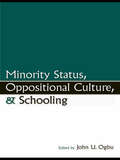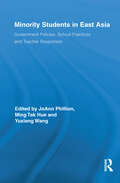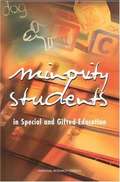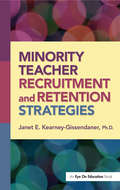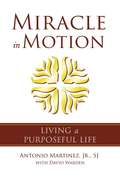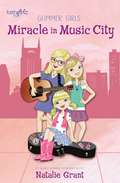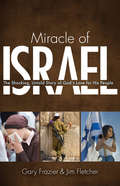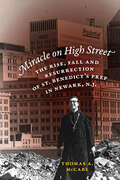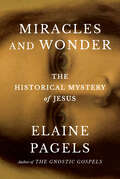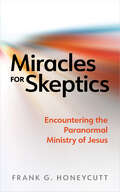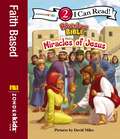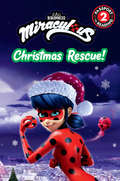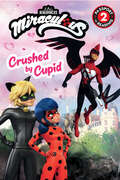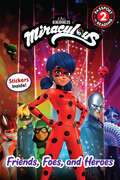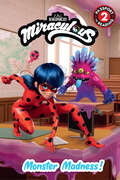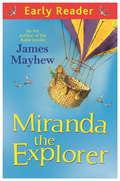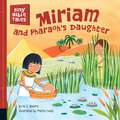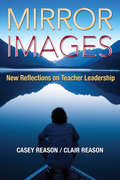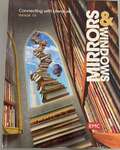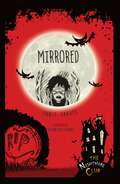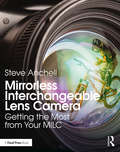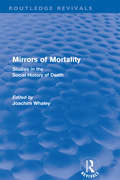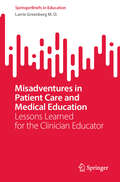- Table View
- List View
Minority Status, Oppositional Culture, & Schooling (Sociocultural, Political, and Historical Studies in Education)
by John U. OgbuThis book is the definitive and final presentation of John Ogbu’s cultural ecological model and the many debates that his work has sparked during the past decade. The theory and empirical foundation of Ogbu’s scholarship, which some have mistakenly reduced to the "acting white hypothesis," is fully presented and re-visited in this posthumous collection of his new writings plus the works of over 20 scholars. Ogbu’s own chapters present how his ideas about minority education and culture developed. Readers will find in these chapters the theoretical roots of his cultural ecological model. The book is organized as a dialogue between John Ogbu and the scholarly community, including his most ardent critics; Ogbu’s own work can be read at the same time as his critics have their say. Minority Status, Oppositional Culture, and Schooling examines content, methodological, and policy issues framing the debate on academic achievement, school engagement, and oppositional culture. It brings together in one volume, for the first time, some of the most critical works on these issues as well as examples of programs aimed at re-engagement. In addition to African Americans, it also looks at school engagement among Native American and Latino students. This book is essential reading for anyone interested in the study of the academic achievement gap.
Minority Students in East Asia: Government Policies, School Practices and Teacher Responses (Routledge Series on Schools and Schooling in Asia)
by JoAnn Phillion Yuxiang Wang Ming Tak HueIn Minority Students in East Asia: Government Policies, School Practices and Teacher Responses authors discuss their research on minority students’ schooling (elementary to higher education) in Mainland China, Hong Kong, Japan, South Korea, and Taiwan. Minority students’ educational issues are often neglected in literature and in practice; social and educational conditions that have resulted from globalization – in particular issues pertaining to minority groups’ education, language and other human rights – receive little attention. In addition, many areas of East Asia have viewed themselves as single-ethnicity countries and have not articulated strong agendas around minority rights. The purpose of this book is to highlight key educational issues for specific minority populations in East Asia. Themes addressed include government policies related to minorities; equity issues in the education of minorities; school practices and teacher perspectives on minorities; identity construction in terms of language and culture; national versus ethnic identity; teacher education issues; and parental concerns. The authors also discuss new theoretical orientations to understanding minority educational issues. A particular strength of this book is the use of multicultural education theories to both articulate concerns related to the education of minority students and to provide solutions to these concerns.
Minority Students in Special and Gifted Education
by National Research CouncilSpecial education and gifted and talented programs were designed for children whose educational needs are not well met in regular classrooms. From their inceptions, these programs have had disproportionate representation of racial and ethnic minority students. What causes this disproportion? Is it a problem?Minority Students in Special and Gifted Education considers possible contributors to that disparity, including early biological and environmental influences and inequities in opportunities for preschool and K-12 education, as well as the possibilities of bias in the referral and assessment system that leads to placement in special programs. It examines the data on early childhood experience, on differences in educational opportunity, and on referral and placement. The book also considers whether disproportionate representation should be considered a problem. Do special education programs provide valuable educational services, or do they set students off on a path of lower educational expectations? Would students not now placed in gifted and talented programs benefit from raised expectations, more rigorous classes, and the gifted label, or would they suffer failure in classes for which they are unprepared?By examining this important problem in U.S. education and making recommendations for early intervention and general education, as well as for changes in referral and assessment processes, Minority Students in Special and Gifted Education will be an indispensable resource to educators throughout the nation, as well as to policy makers at all levels, from schools and school districts to the state and federal governments.
Minority Teacher Recruitment and Retention Strategies
by Janet Kearney-GissendanerThe tools and resources in this book help school leaders seamlessly incorporate minority teacher recruitment and retention programs into current human-resources activities. With details about exemplary minority teacher recruitment and retention programs, this book also showcases strategies for how to replicate such programs in your own school or district. Contents include: A Critical Examination of Teacher Shortages: Thoughts on Needed Change; Identification of Recruitment Models Focused on Minority Teachers: A Theoretical; Concept and Survey; Pipeline Programs for Minority Teacher Recruitment; and Prepare for Action.
Miracle In Motion: Living A Purposeful Life
by David Warden Antonio MartinezRev. T. J. Martinez, SJ is dying of stomach cancer and this book discusses his life before and after he starts a college preparatory school in Texas. This book is beautifully written. It is written to his students at the school: Cristo Rey Jesuit school in Houston, Texas. The Cristo Rey schools were founded to assist the poor to have a good education as preparation for College. He encourages his students by giving them examples from his own life. Not only does he encourage the students but he encourages his readers as well to find meaning, happiness, and most of all, God in their lives.
Miracle in Music City
by Natalie GrantIn this third title in the Faithgirlz Glimmer Girls series by Natalie Grant, Miracle in Music City, the Glimmer Girls are at it again—looking for a mystery to solve. Gloria wants her daughters to learn they aren’t too young to make a difference, so she gets them involved in her annual benefit and auction. But as things often do with the trio of smart and sassy sisters, they get themselves and their nanny Miss Julia involved in a lot more than just helping mom raise money for a worthy and wonderful cause.
Miracle in the Mountains
by Inez Henry Harnett KaneThe book Miracle in the Mountains: The Inspiring Story of Martha Berry's Crusade for the Mountain People of the South tells the story of the educator and founder of Berry College in Rome, Georgia.
Miracle of Israel: The Shocking, Untold Story of God's Love For His People
by Jim Fletcher Gary FrazierEveryone is looking for a miracle. Families devastated by a faltering economy. A college student facing the horrific diagnosis of cancer. Corporately, whole nations are teetering on the brink of despair and chaos. The Miracle of Israel is a stunning examination of the millennia-old love that God has for His people that: Clearly conveys the promise God gave to Abraham Examines the ancient prophecies regarding Israel that have happened and are unfolding even today Provides an easy-to-read timeline of miracle after miracle related to the nation of Israel Tracing the history of the Jewish people to the present day, the authors look at prophecy after prophecy that clearly attest to the Lord's miraculous promises. From historical records to personal, dramatic stories, the Miracle of Israel shows us that in keeping epic promises to the nation of Israel, God's provision for each of us is sure, perfect, and on time, every time.
Miracle on High Street: The Rise, Fall and Resurrection of St. Benedict's Prep in Newark, N.J.
by Thomas A. McCabeJust outside downtown Newark, New Jersey, sits an abbey and school. For more than 150 years Benedictine monks have lived, worked, and prayed on High Street, a once-grand thoroughfare that became Newark’s Skid Row and a focal point of the 1967 riots.St. Benedict’s today has become a model of a successful inner-city school, with 95 percent of its graduates—mainly African American and Latino boys—going on to college. Miracle on High Street is the story of how the monks of St. Benedict’s transformed their venerable yet outdated school to become a thriving part of the community that helped save a faltering city.In the 1960s, after a trinity of woes—massive deindustrialization, high-speed suburbanization, and racial violence—caused an exodus from Newark, St. Benedict’s struggled to remain open. Enrollment in general dwindled, and fewer students enrolled from the surrounding community.The monks watched the violence of the 1967 riots from the school’s rooftop along High Street. In the riot’s aftermath more families fled what some called “the worst city in America.”The school closed in 1972, in what seemed to be just another funeral for an urban Catholic school. A few monks, inspired by the Benedictine virtues of stability and adaptability, reopened St. Benedict’s only one year later with a bare-bones staff . Their new mission was to bring to young African American and Latino males the same opportunities that German and Irish immigrants had had 150 years before.More than thirty years later, St. Benedict’s is one of the most unusual schools in the country. Its remarkable success shows that American education can bridge the achievement gap between white and black, as well as that between rich and poor. The story of St. Benedict’s is about an institution’s rise and fall, resurrection andrenaissance. It also provides valuable insights into American religious, immigration, educational, and metropolitan history. By staying true to their historical values amid a continually changing city, the downtown monks, in resurrecting its prep school, helped save an American city.Some have even called it the miracle on High Street.
Miracles and Wonder: The Historical Mystery of Jesus
by Elaine PagelsFrom a renowned National Book Award–winning scholar, an extraordinary new account of the life of Jesus that explores the mystery of how a poor young man inspired a religion that reshaped the world. <p> Early in her career, Elaine Pagels changed our understanding of the origins of Christianity with her work in The Gnostic Gospels. Now, in the culmination of a decades-long career, she explores the biggest subject of all, Jesus. In Miracles and Wonder she sets out to discover how a poor young Jewish man inspired a religion that shaped the world. <p> The book reads like a historical mystery, with each chapter addressing a fascinating question and answering it based on the gospels Jesus's followers left behind. Why is Jesus said to have had a virgin birth? Why do we say he rose from the dead? Did his miracles really happen and what did they mean? <p> The story Pagels tells is thrilling and tense. Not just does Jesus comes to life but his desperate, hunted followers do as well. We realize that some of the most compelling details of Jesus's life are the explanations his disciples created to paper over inconvenient facts. So Jesus wasn't illegitimate, his mother conceived by God; Jesus's body wasn't humiliatingly left to rot and tossed into a common grave—no, he rose from the dead and was seen whole by his followers; Jesus isn't a failed messiah, his kingdom is a metaphor: he lives in us. These necessary fabrications were the very details and promises that electrified their listeners and helped his followers' numbers grow. <p> In Miracles and Wonder, Pagels does more than solve a historical mystery. She sheds light on Jesus's enduring power to inspire and attract. <b>New York Times Bestseller</b>
Miracles for Skeptics: Encountering the Paranormal Ministry of Jesus
by Frank G. HoneycuttAre the miracle stories in the Bible actually true? Christians and skeptics alike may doubt the veracity of Jesus&’s miracles. Preachers often rely on a dry, literal interpretation of his healings and wonders, or else try to tame them and explain them away rationally. Both approaches, in their obsession with historical accuracy, miss the truth behind these stories. Frank G. Honeycutt draws out the deeper truths in the weird incidents in the Bible. In a warm, conversational style, Honeycutt reads iconic miracle stories—from the wedding at Cana to demonic exorcisms—to enrich the life of faith. Digging into these &“unbelievable&” stories can widen our spiritual imaginations and point to the promise of Christ&’s new world. Pastors seeking thoughtful resources and any inquisitive reader will find a wealth of pastoral insight and scriptural wisdom in Miracles for Skeptics.
Miracles of Jesus: Level 2 (I Can Read! / Adventure Bible)
by ZondervanJesus wanted everyone to know how much God loved them. Read about how Jesus traveled all over Galilee, spreading the good news of God&’s love through his words and amazing miracles.This is a Level Two I Can Read! book, which means it&’s perfect for children learning to sound out words and sentences. It aligns with guided reading level J and will be of interest to children Pre-K to 3rd grade.
Miraculous: Christmas Rescue! (Passport to Reading Level 2)
by Elle StephensCelebrate Christmas with Marinette and Adrien in this festive leveled reader based on Miraculous: Tales of Ladybug & Cat Noir, as seen on Disney! Includes a bonus sheet of stickers!Hawk Moth has turned Santa Claus into a supervillain! Can Ladybug and Cat Noir stop him from ruining Christmas before it's too late? Join Marinette and Adrien as they save the day in this festive leveled reader featuring a bonus sheet of stickers! Perfect for gift giving!Passport to Reading: Featuring a winning combination of favorite licensed characters and carefully controlled text -- reading along or reading alone just got more fun with Passport to Reading! All books include a parent letter, word count, Guided Reading level, and number of sight words.Level 2: Reading out Loud: encourages developing readers to sound out loud, includes more complex stories with simple vocabulary.Miraculous(TM) is a trademark of ZAG(TM) - Method(TM).© 2020 ZAGTOON(TM) - METHOD ANIMATION(TM) - TOEI ANIMATION - SAMG - SK BROADBAND - AB INTERNATIONAL - DE AGOSTINI EDITORE S.p.A. ALL RIGHTS RESERVED.
Miraculous: Crushed by Cupid (Passport to Reading Level 2)
by Elle StephensFall in love with this Valentine's Day leveled reader based on Miraculous: Tales of Ladybug & Cat Noir, as seen on the Disney channel, Netflix, and Disney+! Includes a bonus sheet of stickers!Love is in the air! Marinette wants to tell Adrien that she likes him, but a supervillain named Dark Cupid is trying to ruin everyone's relationships. Can Ladybug and Cat Noir stop this heartbreaker before it's too late? Join Marinette and Adrien as they save the day in this love-filled level reader featuring a sheet of cute stickers!Passport to Reading: Featuring a winning combination of favorite licensed characters and carefully controlled text—reading along or reading alone just got more fun with Passport to Reading! All books include a parent letter, word count, Guided Reading level, and number of sight words.Level 2: Reading out Loud: encourages developing readers to sound out loud, includes more complex stories with simple vocabulary.Miraculous™ is a trademark of ZAGTOON - Method. © 2021 - Zagtoon - Method Animation - Toei Animation - AB Droits Audiovisuels - De Agostini Editore S.P.A. All Rights Reserved.
Miraculous: Friends, Foes, and Heroes (Passport to Reading Level 2)
by Elle StephensMeet Marinette and Adrien, along with their friends, foes, and fellow heroes in this leveled reader based on Miraculous: Tales of Ladybug & Cat Noir, as seen on Disney. Includes a bonus sheet of stickers!By day, Marinette and Adrien are teens living normal lives. But by night, they turn into Ladybug and Cat Noir, superheroes who work together to keep Paris safe from the mysterious villain Hawk Moth. This leveled reader dives into Marinette and Adrien's kwamis, Tikki and Plagg, who help them transform and achieve good all around the world, as well as their best friends, Alya and Nino. Plus, readers will also learn about Hawk Moth's akumas and the times he's transformed people into supervillains!Passport to Reading: Featuring a winning combination of favorite licensed characters and carefully controlled text--reading along or reading alone just got more fun with Passport to Reading! All books include a parent letter, word count, Guided Reading level, and number of sight words.Level 2: Reading out Loud: encourages developing readers to sound out loud, includes more complex stories with simple vocabulary.Miraculous(TM) is a trademark of ZAGTOON - Method.© 2022 ZAGTOON - METHOD ANIMATION - TOEI ANIMATION - SAMG - SKBROADBAND - AB INTERNATIONAL - DE AGOSTINI EDITORE S.p.A. ALL RIGHTS RESERVED.
Miraculous: Monster Madness! (Passport to Reading Level 2)
by Elle StephensPerfect for spook-tacular Halloween reading, join Marinette and friends in this hair-raising leveled reader based on Miraculous: Tales of Ladybug & Cat Noir, as seen on the Disney channel, Netflix, and Disney+! Includes a bonus sheet of stickers!While filming a scary movie for Marinette's class, Hawk Moth turns the lead actress into a supervillain that feeds on fear! Can Ladybug and Cat Noir stop this movie monster before she ruins their film? Join Marinette and Adrien as they save the day in this spooky leveled reader featuring a bonus sheet of stickers!Passport to Reading: Featuring a winning combination of favorite licensed characters and carefully controlled text--reading along or reading alone just got more fun with Passport to Reading! All books include a parent letter, word count, Guided Reading level, and number of sight words.Level 2: Reading out Loud: encourages developing readers to sound out loud, includes more complex stories with simple vocabulary.Miraculous (TM) is a trademark of ZAG - Method.© 2021 ZAGTOON - METHOD ANIMATION - TOEI ANIMATION - SAMG - SK BROADBAND - AB INTERNATIONAL - DE AGOSTINI EDITORE S.p.A. ALL RIGHTS RESERVED.
Miranda The Explorer
by James MayhewEarly Readers are stepping stones from picture books to reading books. A blue Early Reader is perfect for sharing and reading together. A red Early Reader is the next step on your reading journey.Miranda wins a balloon ride - but the rope snaps and away she goes, over seas, mountains and deserts. She touches down at the Taj Mahal and the Pyramids, flies over the Great Wall of China, visits Japan, almost falls into a river full of crocodiles in Australia, makes some new friends at the Leaning Tower of Pisa - and much more.
Miranda The Explorer (Early Reader)
by James MayhewEarly Readers are stepping stones from picture books to reading books. A blue Early Reader is perfect for sharing and reading together. A red Early Reader is the next step on your reading journey.Miranda wins a balloon ride - but the rope snaps and away she goes, over seas, mountains and deserts. She touches down at the Taj Mahal and the Pyramids, flies over the Great Wall of China, visits Japan, almost falls into a river full of crocodiles in Australia, makes some new friends at the Leaning Tower of Pisa - and much more.
Miriam and Pharaoh's Daughter (Tiny Bible Tales)
by W. C. BauersTiny Bible Tales, a series of board books, shares the stories of the Bible's bravest heroes with gentle, rhyming text and gorgeous illustrations.To save baby Moses, Miriam and her mother place him in a basket and set him adrift on the river. As Miriam watches from the reeds, she hopes that someone will find and rescue him. And someone does--Pharaoh's daughter! This board book combines quiet, rhyming text with simple and colorful art to tell one of the Bible's most treasured stories.
Mirror Images: New Reflections on Teacher Leadership
by Casey S. Reason Clair M. ReasonReflections on the new teacher leaders Mirror Images takes a comprehensive look at what teacher leadership means today and how teachers can transform the future of their profession. Included are ten iconic images of teacher leadership roles to help teachers move beyond teaching as they were taught. The authors make a compelling case for the importance of teacher leadership today based on these current conditions: Top-down change is less effective today than ever, Teacher leadership in schools is a force, not a position, Old stereotypes of teaching keep teachers from striving for more, Leadership, learning, and change are united.
Mirror and Windows: Connecting with Literature
by Brenda OwensMirrors & Windows - Connecting with Literature - Grade 10
Mirrored (The Nightmare Club #3)
by Annie GravesThe Nightmare Club is not for just ANYBODY. Only the spookiest, scariest stories get told at Annie's Halloween sleepovers―and if you can't take it, well, tough! Abbey's best friend is her reflection―Bee, the mysterious girl who looks just like her and lives on the other side of her mirror. Bee understands Abbey better than anyone else. But does Abbey really trust Bee...enough to switch places with her?
Mirrorless Interchangeable Lens Camera: Getting the Most from Your MILC
by Steve AnchellMirrorless interchangeable lens cameras are changing the way images are captured, being far more in line with modern photography trends and sensibilities. With Mirrorless Interchangeable Lens Camera: Getting the Most from Your MILC, you’ll learn why this is happening and how to get the most from your mirrorless camera. This guide covers everything you need to know about the difference between a mirrorless camera and a DSLR, apps, lenses, video recording, and picture profiling features. You’ll learn how to use your mirrorless interchangeable lens camera for different genres of photography including landscape, travel, low light, street photography, portraiture, and more. Written by expert and skilled instructor Steve Anchell, this book includes 198 inspirational and instructional images with 154 in full-color, with insights and photographs from 9 professional photographers. It’s the perfect guide for established photographers not yet aware of the wealth of benefits mirrorless interchangeable lens cameras offer and for beginning photographers just starting their career.
Mirrors of Mortality: Social Studies in the History of Death (Routledge Revivals)
by Joachim WhaleyFirst published in 1981, this reissue examines mankind’s preoccupation with death and mortality by isolating various societies in different periods of time. The authors examine not only the formal rituals associated with the last rite of passage, but also the social attitudes to death and dying which these rituals evidence. The essays establish that different periods do seem to be characterized by different images of death and attitudes to it, but the authors wisely avoid trying to impose strict chronological pattern. A pioneering work in the historical study of attitudes to death, this reissue should reignite discussion on the significance of death in human history. Christiane Sourvinou-Inwood examines attitudes to death as reflected in myth and religious thought in Ancient Greece and relates them to social and economic change. R. C. Finucane analysis the social significance of the ‘exemplary’ deaths of kings, criminals, traitors and saints in medieval Europe. Paul Fritz’s essay illustrates the importance of royal burials in early modern Britian; while Joachim Whaley examines the social and political significance of funerals in Hamburg between 1500 and 1800. John McManners discusses the work of Phililppe Aries and other prominent French scholars on the history of attitudes to death. David Irwin examines the images of death portrayed in European tombs around 1800. C.A Bayly analyzes the relationship between death ritual and society in Hindu Northern India, while David Cannadine discusses the impact of war on attitudes to death in modern Britain.
Misadventures in Patient Care and Medical Education: Lessons Learned for the Clinician Educator (SpringerBriefs in Education)
by Larrie Greenberg M.D.This book offers a perspective not often addressed in medicine and medical education: errors or misadventures in patient care and education. In 1999, a white paper was created by the Institute of Medicine—"To Err is Human: Building a Safer Health System"—that addressed errors made around patient care and what that cost is in lives and dollars to the public each year. This initiative resulted in more safeguards in the system, including attention to quality improvement. In fact, whereas there has been a focus on patient safety since that paper, the same emphasis has been lacking in medical education, the foundation of which represents how we teach future physicians. There currently are no other books on the topics of patient care and education, with Jerome Groopman's Book on &‘&’How Doctors Think&’&’ being one of the few publications that focuses on errors in patient care but not necessarily how to avoid or correct those errors. This book is divided into major activities for those faculty in academic health settings, physicians and non-physicians, who assume the major responsibility for teaching, patient care, educational scholarship, mentoring, and administrative duties. These are, by definition, clinician educators (CE) and include all those in academic health centers, physicians and non-physicians who care for patients and teach future practitioners. In fact, medical and health science students in addition to resident trainees would benefit from reading this book as they traverse curricula aimed at educating future practitioners. The book is divided into sections based on responsibilities noted above, e.g., teaching and patient care, and I point out common errors in the healthcare team performance, with comments on how to address those errors. I cover all the responsibilities of clinician educators in academic medical centers, including leadership or administrative skills. The content is largely based on the author's long experience as a CE in addition to evidence-based information about patient care and educational theory.
